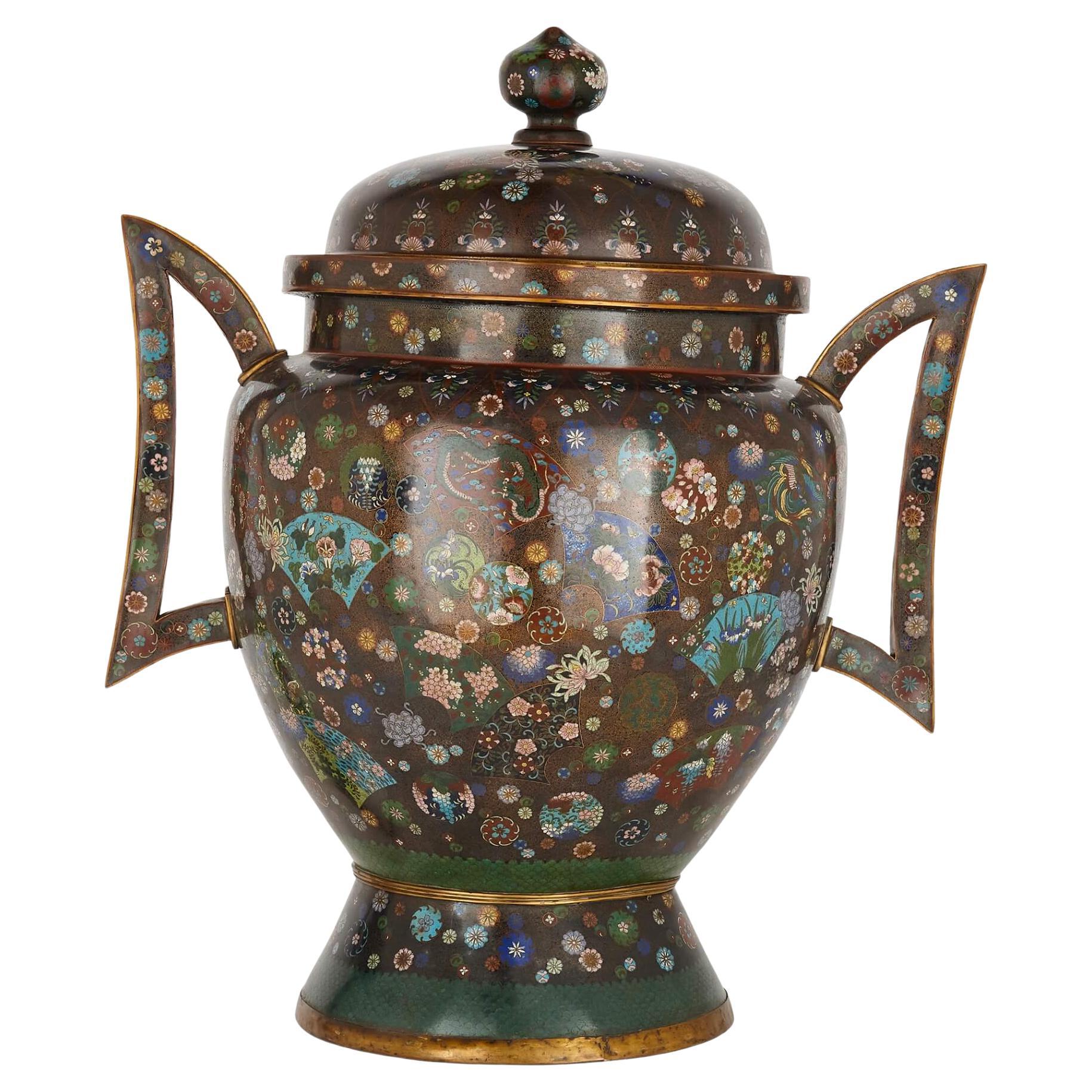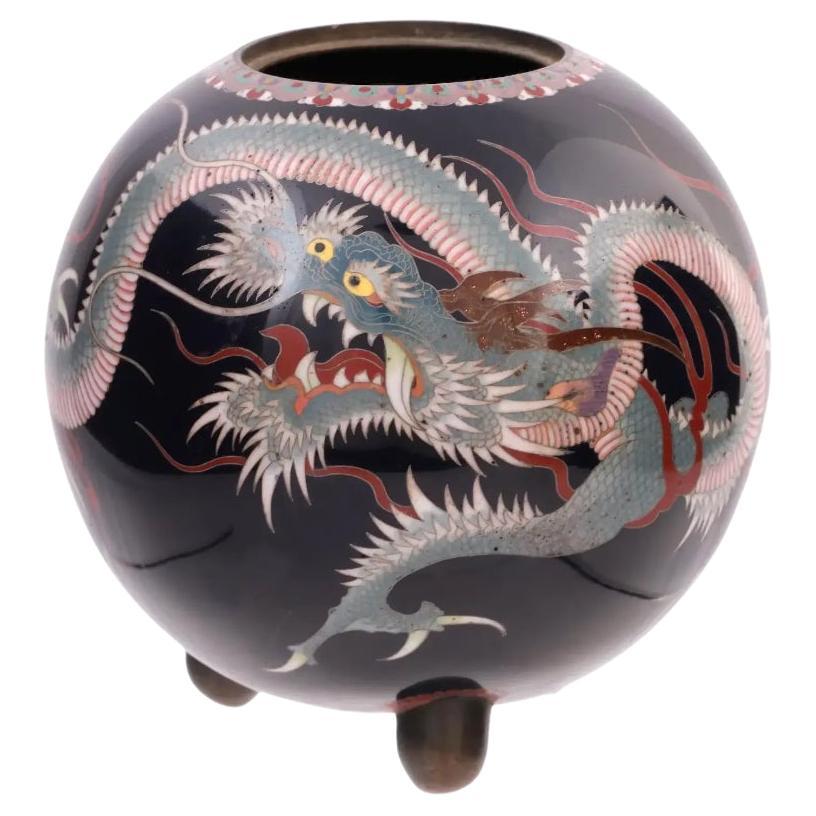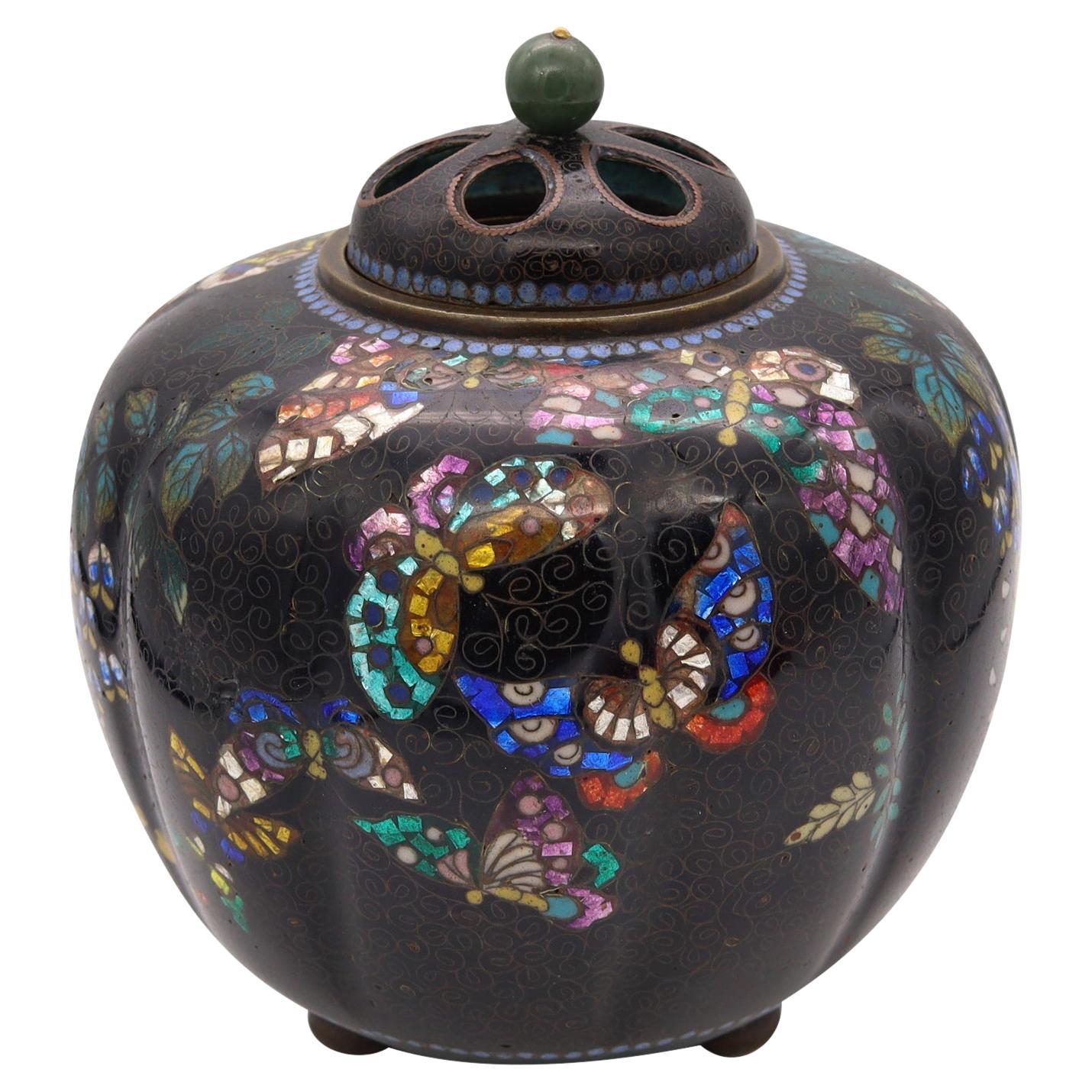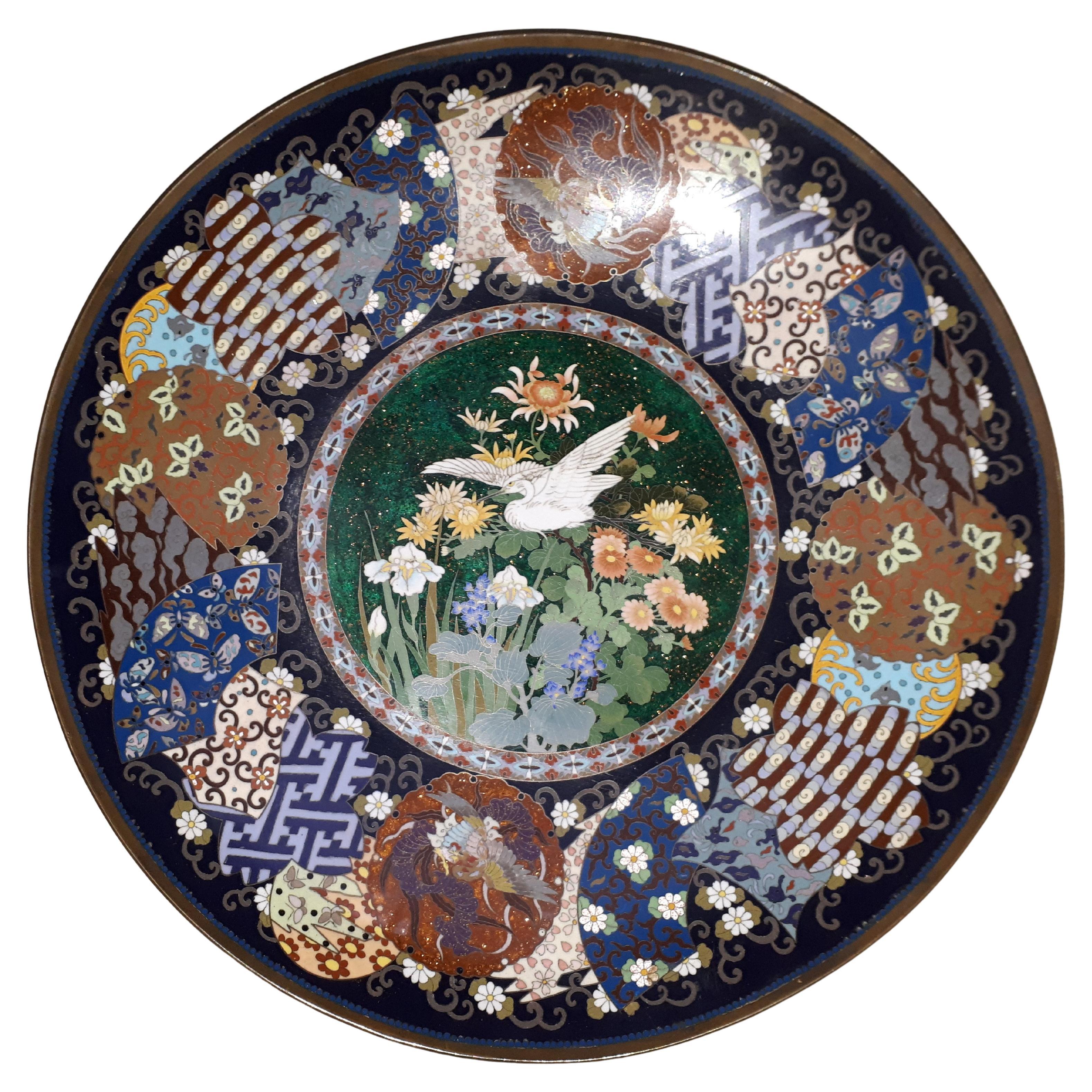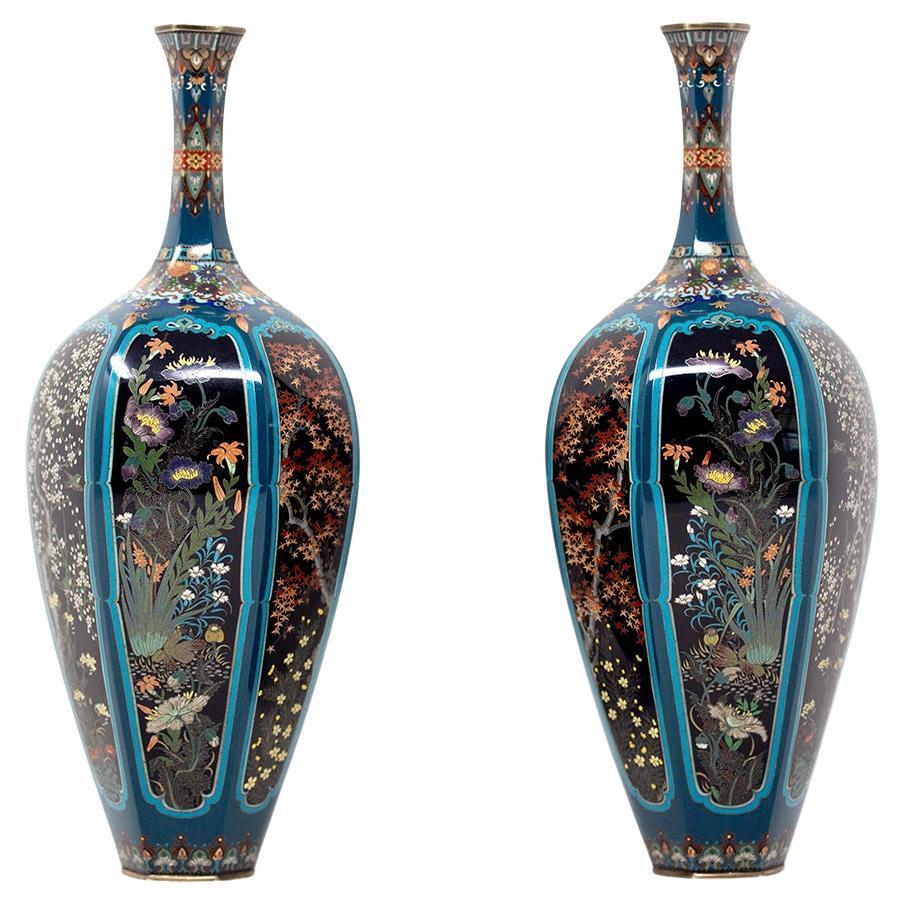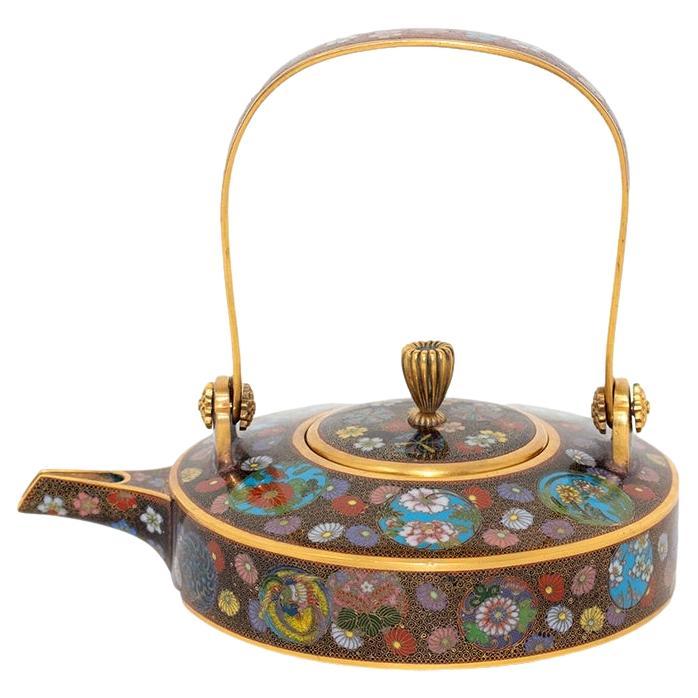Items Similar to Japanese Meiji Period Cloisonne Enamel Koro signed Tsukamoto Hikokichi
Want more images or videos?
Request additional images or videos from the seller
1 of 21
Japanese Meiji Period Cloisonne Enamel Koro signed Tsukamoto Hikokichi
About the Item
The Koro of exceptional quality shaped in bulbous squat form with three looped handles and removable lid raised on three tapered feet. The Koro with a sky blue ground decorated extensively with Ho-o birds to the lid, alternating ginbari panels with twin Ho-o birds and a geometric border with scrolling black enamel lines and silver wire inlay. The feet decorated with scrolling black enamel finished with brass pins to protect the enamel on the surface. The centre of the base is inlaid with the makers signature within a red cartouche for Tsukamoto Hikokichi. The Koro dates to the Meiji Period (1868-1912) circa 1910.
Meiji Period was an era of Japanese history that spanned from 1868 to 1912. It was the first half of the Empire of Japan, when the Japanese people began to build a paradigm of a modern, industrialised nation state and emergent great power, influenced by Western countries and aesthetics. As a result of radically different ideas, the changes to Japan were profound and it affected the social structure, politics, economy, military, and foreign relations across the board. The period corresponded to the reign of Emperor Meiji and was preceded by the Keio era and was succeeded by the Taisho era.
Cultural Art during the Meiji Period was of particular interest to the government and they overhauled the art export market which in turn promoted Japanese arts via various world’s fairs, beginning in Vienna at the world fair in 1873. The government heavily funded the fairs and took an active role organising how Japan’s culture was presented to the world including creating a semi-public company named Kiritsu Kosho Kaisha (First Industrial Manufacturing Company). The Kiritsu Kosho Kaisha was used to promote and commercialise exports of Japanese art and established the Hakurankai Jimukyoku (Exhibition Bureau) to maintain quality standards. For the 1876 Centennial International Exhibition in Philadelphia, the Japanese government created a Centennial Office and sent a special envoy to secure space for the 30,000 items that would be displayed. The Imperial Household also took an active interest in arts and crafts, commissioning works by select artists to be given as gifts for foreign dignitaries further emphasising the high quality and importance of Japanese art. Just before the end of the 19th century in 1890, the Teishitsu Gigeiin (Artist to the Imperial Household) system was created to recognise distinguished artists. These artists were selected for their exceptionally high quality wares and talent in their own industry. Over a period of 54 years Seventy artists were appointed, amongst these were ceramicist Makuzu Kozan and cloisonné enamel artist Namikawa Yasuyuki.
Ginbari is a type of cloisonne with clear enamel over a stippled silver layer applied to the copper sheet body.
Ho-o represents fire, the sun, and the imperial family. It also stands for the virtues of duty, propriety, faith, and mercy. Its five colors represent the five elements of wood, fire, earth, metal, and water. Ho-o came from Chinese mythology, where they are known as fenghuang.
Measurements (centimetres) 10cm High x 9cm Diameter
- Dimensions:Height: 3.94 in (10.01 cm)Diameter: 3.54 in (9 cm)
- Style:Meiji (Of the Period)
- Materials and Techniques:
- Place of Origin:
- Period:
- Date of Manufacture:Circa 1910
- Condition:
- Seller Location:Newark, GB
- Reference Number:
About the Seller
5.0
Vetted Seller
These experienced sellers undergo a comprehensive evaluation by our team of in-house experts.
Established in 2019
1stDibs seller since 2022
18 sales on 1stDibs
Typical response time: 3 hours
- ShippingRetrieving quote...Ships From: Newark, United Kingdom
- Return PolicyA return for this item may be initiated within 14 days of delivery.
More From This SellerView All
- Japanese Cloisonne Enamel Vase Pair Meiji PeriodLocated in Newark, EnglandA sensational pair of Japanese Meiji period Cloisonne enamel bottle vases. The vases of slender hexagonal form with trumpet opening upon a circular foot. Decorated to the highest qua...Category
Antique Late 19th Century Japanese Meiji Metalwork
MaterialsMetal, Silver
- Japanese Meiji Period Cloisonne Enamel Sake PotLocated in Newark, EnglandFine Japanese Meiji period cloisonne enamel Sake pot. The Sake pot of rounded form with with clean edges profusely decorated with blossoming flowers throughout upon a black ground ba...Category
Antique Late 19th Century Japanese Meiji Metalwork
MaterialsMetal, Enamel
- Japanese Meiji Period Silver Box Signed MasayukiLocated in Newark, EnglandJapanese Meiji period silver box with shibuichi plaque dating circa 1900. The box of rectangular form with a silver polished case stamped Jungin (J...Category
Antique Early 1900s Meiji Metalwork
MaterialsSilver
- Japanese Cloisonne Enamel Chrysanthemum Vase Signed Ando CompanyBy Ando JubeiLocated in Newark, EnglandJapanese cloisonne enamel Chrysanthemum vase Tashio-early Showa period. The vase of bulbous form boldly decorated with a vivid green base enamel and...Category
Mid-20th Century Japanese Meiji Metalwork
MaterialsSilver, Enamel, Wire
- Japanese Musen Wireless Cloisonne Enamel Vase Signed Ando CompanyBy Ando JubeiLocated in Newark, EnglandJapanese musen wireless cloisonne enamel vase early Showa period. The vase of globular form decorated in a mint green enamel with a band of abstract...Category
Mid-20th Century Japanese Meiji Metalwork
MaterialsMetal, Silver, Enamel, Wire
- Antique Japanese Meiji Period Iron BoxLocated in Newark, EnglandMeiji Period (1868-1912) From our Japanese collection, we are delighted to offer this Antique Japanese Meiji Period Iron Box. The Box of slim rectangular form cast in iron and raise...Category
Antique 1890s Japanese Meiji Metalwork
MaterialsSilver, Enamel, Iron
You May Also Like
- Large Meiji Period Cloisonne Enamel KoroLocated in London, GBLarge Meiji Period Cloisonne Enamel Koro Japanese, late 19th Century Height 88cm, width 76cm, depth 53cm This superb cloisonne enamel koro was made during Japan's Meiji period, and ...Category
Antique Late 19th Century Japanese Meiji Metalwork
MaterialsBronze, Enamel
- Antique Meiji Japanese Cloisonne Enamel Dragon Censor KoroLocated in New York, NYAn antique Japanese, late Meiji Era, tripod enamel censer koro. The sphere form ware is enameled with a polychrome image of a dragon on a black ground made in the Cloisonne technique...Category
Antique Late 19th Century Japanese Meiji Metalwork
MaterialsEnamel
- Japan 1890 Meiji Period Bronze Koro Censer in Cloisonne Enamel with Jade LidLocated in Miami, FLJapanese Koro from the Meiji Period (1868-1912). Beautiful antique ten sides fluted koro censer, created in Japan during the Meiji period (1868-1912), ci...Category
Antique 1890s Japanese Meiji Metalwork
MaterialsJade, Gold, Silver, Bronze, Enamel
- Large Japanese Cloisonné Enamel Dish, Japan Meiji periodLocated in Saverne, Grand EstBronze and cloisonné enamel dish very finely decorated with an egret in flight above various flowers on a background of copper inclusions and gold powder. The wing decorated in parti...Category
Antique Late 19th Century Japanese Meiji Metalwork
MaterialsBronze
- Small Japanese Cloisonné Censer, Koro, Meiji Period, Late 19th Century, JapanLocated in Austin, TXA small and delightful Japanese cloisonné and goldstone tripod incense burner and cover, Meiji period, late 19th century, Japan. The small incense burner...Category
Antique Late 19th Century Japanese Meiji Metalwork
MaterialsCopper, Enamel
- Japanese Cloisonne Enamel Meiji Period 6 Pcs Writing SetLocated in New York, NYA Japanese Meiji period cloisonne enamel writing set comprising 6 pieces decorated in the same style with floral patterns, including an oval tray, two plates and three cups of variou...Category
Antique Late 19th Century Japanese Meiji Metalwork
MaterialsEnamel
Recently Viewed
View AllMore Ways To Browse
Bronze Dancing Shiva Nataraja
Eternity Bands 475
Large Republic Period Cloisonne Vase
Tibet Gold Solid
Bronze Japanese Samurai On Dragon
Iron Kama
Antique Japanese Mixed Metal Box
Asian Silver Belt
Cast Iron Teapot
Chinese Knockers
Bronze Elephant Incense
Japanese Iron Tetsubin
Japanese Tetsubin
Qajar Moorish
Shakudo Box
Antique Tibetan Bell
Cloisonne Fish Bowl
17th Century Chinese Cloisonne
